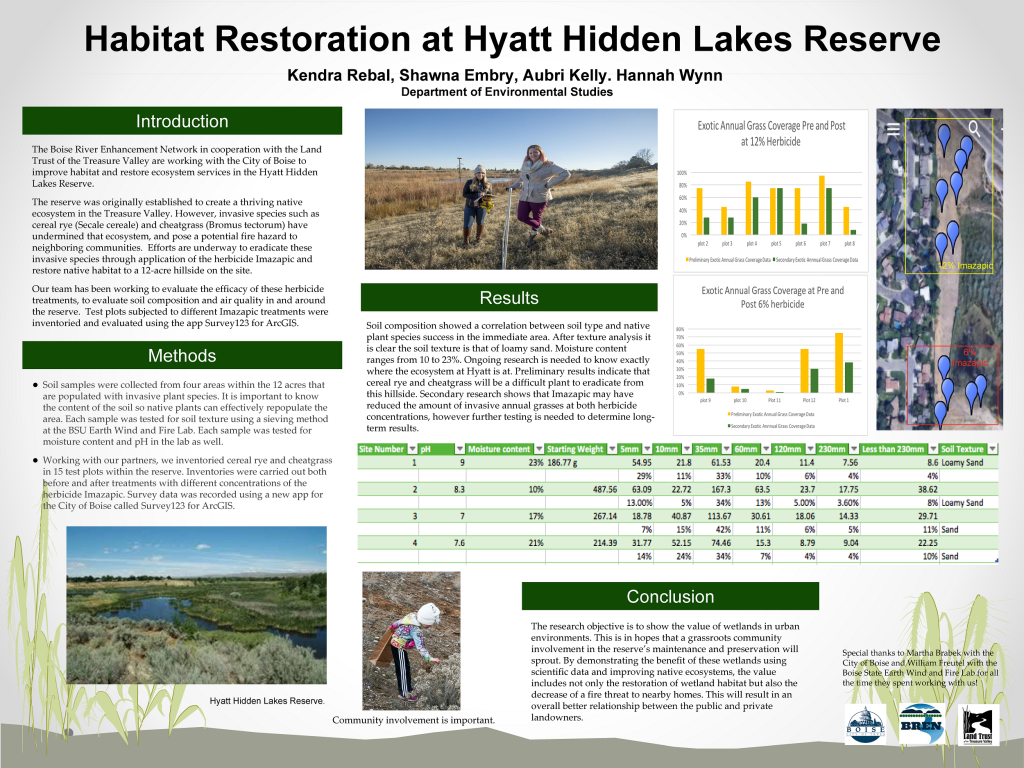Habitat Restoration at Hyatt Hidden Lakes Reserve

Kendra Rebal, Shawna Embry, Aubri Kelly. Hannah Wynn
Department of Environmental Studies
Introduction
The Boise River Enhancement Network in cooperation with the Land Trust of the Treasure Valley are working with the City of Boise to
improve habitat and restore ecosystem services in the Hyatt Hidden Lakes Reserve.
The reserve was originally established to create a thriving native ecosystem in the Treasure Valley. However, invasive species such as cereal rye (Secale cereale) and cheatgrass (Bromus tectorum) have undermined that ecosystem, and pose a potential fire hazard to neighboring communities. Efforts are underway to eradicate these invasive species through application of the herbicide Imazapic and restore native habitat to a 12-acre hillside on the site.
Our team has been working to evaluate the efficacy of these herbicide treatments, to evaluate soil composition and air quality in and around the reserve. Test plots subjected to different Imazapic treatments were inventoried and evaluated using the app Survey123 for ArcGIS.
Methods
- Soil samples were collected from four areas within the 12 acres that are populated with invasive plant species. It is important to know the content of the soil so native plants can effectively repopulate the area. Each sample was tested for soil texture using a sieving method at the BSU Earth Wind and Fire Lab. Each sample was tested for moisture content and pH in the lab as well.
- Working with our partners, we inventoried cereal rye and cheatgrass in 15 test plots within the reserve. Inventories were carried out both
before and after treatments with different concentrations of the herbicide Imazapic. Survey data was recorded using a new app for the City of Boise called Survey123 for ArcGIS.
Results
Soil composition showed a correlation between soil type and native plant species success in the immediate area. After texture analysis it is clear the soil texture is that of loamy sand. Moisture content ranges from 10 to 23%. Ongoing research is needed to know exactly where the ecosystem at Hyatt is at. Preliminary results indicate that cereal rye and cheatgrass will be a difficult plant to eradicate from this hillside. Secondary research shows that Imazapic may have reduced the amount of invasive annual grasses at both herbicide concentrations, however further testing is needed to determine longterm results.
Conclusion
The research objective is to show the value of wetlands in urban environments. This is in hopes that a grassroots community involvement in the reserve’s maintenance and preservation will sprout. By demonstrating the benefit of these wetlands using scientific data and improving native ecosystems, the value includes not only the restoration of wetland habitat but also the decrease of a fire threat to nearby homes. This will result in an overall better relationship between the public and private landowners.
Special Thanks
Special thanks to Martha Brabek with the City of Boise and William Freutel with the Boise State Earth Wind and Fire Lab for all the time they spent working with us!